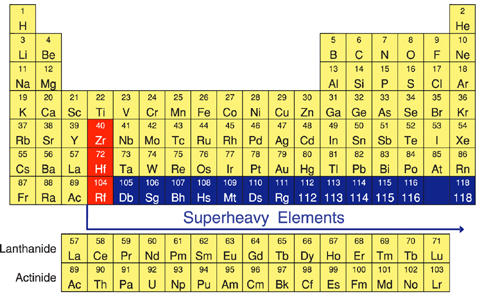
Fig.6-2 Periodic table of the elements

Fig.6-3 Variations of distribution coefficients (Kd) of rutherfordium (Rf), zirconium (Zr) and hafnium (Hf) as a function of the concentration of the nitrate ion
Superheavy elements with atomic numbers ≥ 104 are currently placed on the uppermost end of the periodic table as shown in Fig.6-2. Chemical properties of lighter elements arranged in the same columns of the periodic table show gradual variation, and those of superheavy elements are theoretically expected to have greater deviations among homologues due to strong relativistic effects on their electronic structure.
In the present study, we studied anion-exchange behavior of element 104, rutherfordium (Rf) in hydrofluoric acid and nitric acid (HF/HNO3 ) mixed solutions. The Rf atoms were produced in the nuclear reaction between a 248Cm target and 18O beams delivered from the JAEA tandem accelerator. It was clarified for the first time that the properties of fluoro complexes of Rf are significantly different from those of its lighter homologues Zr and Hf.
In Fig.6-3, the variations of distribution coefficients (Kd ) of Rf, Zr and Hf are shown as a function of the concentration of the nitrate ion. Kd is the concentration ratio of the element in the resin phase to that in aqueous solution; larger Kd shows stronger adsorption on the resin. The Kd values of Rf, Zr and Hf decreased with increase in the concentration of the nitrate ion. These decreasing trends indicate that the nitrate ions entering in the binding sites of the anion-exchange resin drive the anionic fluoride-complexes of Rf, Zr, and Hf out of the resin into the aqueous solution. The slopes in the logarithmic plot of Kd vs. the concentration of the nitrate ion are -2 for all the elements. These -2 slopes show that the anionic fluoride-complexes have the same -2 charges, clearly demonstrating that Rf forms a hexafluoro complex, [RfF6 ]2-, as do Zr and Hf. It was also found that the Kd values of Rf are smaller than those of the homologues by about 2 orders of magnitude. We further investigated the variation of the Kd values depending on the concentration of the fluoride ion to understand the difference in the Kd values. We then found that about 2 orders of higher concentration of the fluoride ion is necessary to form [RfF6] 2- than that to form [ZrF6 ]2- and [HfF6 ]2-. It was thus understood that the difference in Kd between Rf and its homologues in Fig.6-3 results from the fact that Zr and Hf have completely formed hexafluoro complexes while the Rf complex is incomplete at the concentration of fluoride ions used.
This suggests that Rf4+ has a larger ionic radius than Zr4+ and Hf4+ because formation of fluoro complexes of the group-4 elements depends on the ionic radii of the tetravalent ions. An ionic radius of Rf would be influenced by the relativistic effects that change the electronic structure of Rf. Although it has not so far known how relativistic effects change the ionic radii, the present result is a key to solve the question.